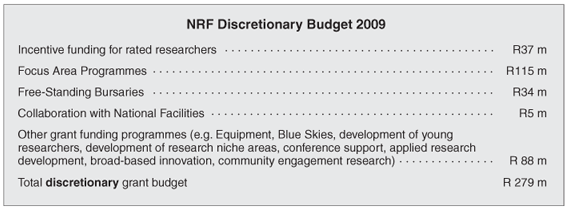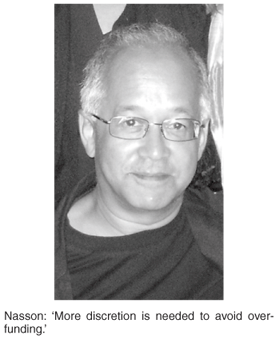Servicios Personalizados
Articulo
Indicadores
Links relacionados
-
 Citado por Google
Citado por Google -
 Similares en Google
Similares en Google
Compartir
South African Journal of Science
versión On-line ISSN 1996-7489
versión impresa ISSN 0038-2353
S. Afr. j. sci. vol.105 no.3-4 Pretoria mar./abr. 2009
NEWS FEATURE
Funding crisis jeopardises Ph.D.s
Craig McKune
Science journalist based in Cape Town
Three years ago, the National Research Foundation and the Department of Science and Technology jointly launched a programme to increase the number of Ph.D. graduates in the country—currently approximately 1 200 annually—fivefold by 2018. But government's ability to pull this off is now in question as the department this year reduced its subsidy to the foundation, which is the agency responsible for funding graduate students in South Africa. Furthermore, the role of the foundation itself is being questioned by many researchers, who believe it is failing to disburse funds judiciously.
In terms of Ph.D. production, South Africa's performance is well below other emerging economies (http://www.dst. gov.za/publications-policies/strategies- reports/The%20Ten-Year%20Plan%20 for%20Science%20and%20Technology. pdf). The country currently graduates an annual 27 Ph.D.s per million of population, compared with Brazil's 42 and South Korea's 172, not to mention 240 in Australia or 259 in the U.K. The planned fivefold boost should be important for the country to compete economically with other developing countries.
The department aims specifically to boost numbers of science, engineering and technology graduates—numbering 561 in 2005—to 3 000. Asked if he thought these increases were realistic, Robin Drennan, executive director for grant management and systems administration at the foundation, replied: 'It's not a pipedream, but it is a stretch target.'
The department's explanation for the cut is that the global economic crisis forced them to slash budgets throughout. While their subsidies to public institutions engaged with scientific and technological activities dropped between 2008 and 2009, not all their beneficiaries have suffered cuts of similar magnitude: the subsidy for the Council for Scientific and Industrial Research, for example, was boosted from R534 749 million to R561 487 million, while the NRF's subsidy of R680 396 is a decrease from last year's R680 832 (see box on p. 84).
After more than six weeks, an explanation has still not been forthcoming from the department as to why the foundation's subsidy in particular had been singled out for cuts in the context of their funding the Ph.D. programme. At the time of going to press, spokesperson Nhlanhla Nyide said that a detailed response was still waiting to be approved, but he claims that the department is still prioritising its Ph.D. project, and has not lost faith in the foundation to deliver on it. Nyide acknowledges that tensions do 'naturally' exist between the two bodies over implementation and targets, but said that the department was 'absolutely satisfied' that the foundation was 'doing its job'.
Just under half of the Ph.D. students supported by the foundation are funded from their 'discretionary budget', which is allocated by the department and which increased by only two per cent this year. While the number of Ph.D. students supported by the foundation's discretionary budget rose from 1 100 in 2004 to a peak of 1 197 in 2006, it then declined to 1 037 last year. The cause of this is almost certainly the implementation of the Incentive programme last year, which is at odds with the aim of increasing the production of doctoral graduates, as studentships and running expenses are not embedded in it as they were in the Focus Area Programmes (FAPs). The Incentive programme provides 'glue funding' to rated researchers, which they are supposed to receive for the duration of their rating cycle: A-rated researchers should receive R100 000 annually; B-rated researchers R80 000; and C-rated researchers R40 000.
The foundation has come under fire from dissatisfied researchers for its strategic decision to replace the FAPs with the new funding framework. Drennan says that the FAPs are being phased out over four years—by which time all existing grants would have run their course—and as money becomes available it will be channelled to the new framework, which so far comprises four programmes: the Incentive Programme, the Blue Skies Programme, Collaboration with National Facilities and Competitive Support for Unrated Researchers (see box below).

Both the FAPs and the new framework are funded from the foundation's 'discretionary budget'—which is currently R279 million and provided by the department. Also channelled from the department to the foundation this year is R171 million in 'ring-fenced' grants for specific initiatives including the research chairs, the centres of excellence, and more specialised foci such as the Coelacanth Conservation and Genome Resource Programme and the National Bioinformatics Institute. Administration costs (including salaries) and funds for running the national facilities make up the balance of its subsidy from the department. In addition, the foundation should receive an estimated R870 million this year in contract funding from various other government departments for specific projects, including the Scarce Skills Programme and the Technology and Human Resources for Industry Programme.
The Blue Skies Programme, in particular, has been controversial: its aim is to focus on 'novel research'. Only R7 million is available for the programme this year, but Drennan says this will grow over the next four years as the FAPs are phased out. The new framework, he says, is intended to last at least until 2015.
In the review process for the Blue Skies Programme, proposals addressing important, 'basic' scientific questions, with clear experimental designs and sound hypotheses were immediately rejected, if they were based on past research. This means that most researchers have to rely on relatively small amounts of incentive funding—assuming they receive it—when their FAP funding comes to an end. A Competitive Support for Rated Researchers programme will cover such research, but this will be the last to be phased in: 'within about the next four years', according to Drennan.

Consequently, 'very good, well-established scientists with excellent projects cannot continue with their work,' according to Stellenbosch University medical researcher Paul van Helden. This is because in targeting 'novel' research, the programme excludes any proposals that are a continuation of any existing research whatsoever.
'Researchers are looking at this and seeing they've got no way to support their projects and take them to the next logical step,' said van Helden. 'There is a nasty gap in the funding, and it impacts on researchers' momentum. They've had it at the moment. There's nowhere for them to go.'
And researchers say the foundation's communication about their new strategy has been unclear. In the call for proposals to the Blue Skies programme last year, it was stated that it would focus on 'fundamental, curiosity-driven and basic' research, but nowhere did it state that the proposals should not be based on existing research. 'A lot of us had the impression that the Blue Skies programme would fill in for the FAPs,' says University of Pretoria zoologist Sue Nicolson, who is a typical victim of the new framework: her Focus Area grant has terminated, and her Blue Skies proposal was rejected, leaving her relying solely on glue funding.

Compounding the view that the foundation is botching its implementation of the new framework, the agency reneged on an assurance that proposals would be sent out for written peer review. In its call for applications, the agency stated that proposals would be assessed in a two-tiered process: postal peer review and an assessment panel. For at least one panel review, members received the applications only 24 hours before the meeting took place, giving them too little time to prepare (see SAJS 105, 10; 2009).
Drennan disputes this, and claims that on average panel members were sent their documents, via courier, 11 days before their meetings. 'Should any panel member have actually received their documents closer to the meeting I can only apologise,' he says. He says the 300-odd applications received for the Blue Skies programme were divided among 14 panels, and were sent out for written review, but that the process was abandoned because the response was so poor. He was unable to provide details on how timeously proposals had been sent out.
To make matters worse, the Incentive programme has been implemented in a piecemeal fashion. Last year all rated researchers not receiving any other funds from the foundation were guaranteed glue funding for five years, but this year glue funding was awarded only to A-, P- and some B-rated researchers. Drennan explains that this is part of the phase-in process: they began to move down the hierarchy of rated researchers until they ran out of funds. But glue funding has been awarded irrespective of what a researcher's costs really are (research on molecular biology is more expensive to conduct than that on literary theory, for example), or whether researchers received funds from alternative sources. 'More discretion is needed to avoid overfunding,' says A-rated historian Bill Nasson of the University of Cape Town.

'We debated it and decided [the phasing in of glue funds] would be the most effective way of funding them all,' said Drennan. He acknowledges that the phase-in process has not been perfect, and emphasises they were not planning to turn their back on productive researchers not conducting 'novel' research. 'We're caught in a situation where we're trying to accommodate everyone from a discretionary budget that is not keeping pace with inflation. [The process] is not ideal or smooth, but it's the best we can do under the circumstances.'
In a further threat to the foundation's ability to boost Ph.D. output, the Department of Labour did not renew its scarce skills funding this year, even though the foundation had allocated scarce skills bursaries to over 800 students. To honour these commitments, Drennan says they have been forced to dip into their already strained discretionary budget.
Nicolson echoes the feelings of many researchers when she says: 'There is a paradox here: at the same time that they want us to train more Ph.D.'s, the funding gets cut.'














